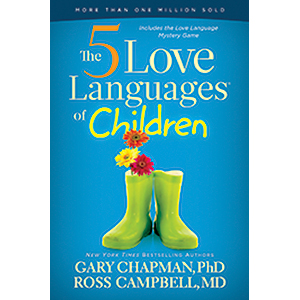 “In modern society, raising emotionally healthy children is an increasingly difficult task,” explains Gary Chapman and Ross Campbell. But as far as these authors of The Five Love Languages of Children are concerned, “If children feel genuinely loved by their parents, they will be more responsive to parental guidance in all areas of their lives.”
“In modern society, raising emotionally healthy children is an increasingly difficult task,” explains Gary Chapman and Ross Campbell. But as far as these authors of The Five Love Languages of Children are concerned, “If children feel genuinely loved by their parents, they will be more responsive to parental guidance in all areas of their lives.”
Now, I know what you’re thinking, “Of course, my child knows I love her. I always tell her. I buy her treats. I even take her special places.” But what I hadn’t realized until I read The Five Love Languages of Children a few years ago was that if I’m not talking to my child in her love language then my message isn’t getting through. Ultimately, applying the concepts in this book worked so well, I’m rereading it to share with you.
According to Chapman and Campbell, there are five ways children speak and understand emotional love: physical touch, words of affirmation, quality time, gifts, and acts of service. “If you have several children in your family, chances are they speak different languages, for just as children often have different personalities, they may hear in different love languages.”
Love Language #1 – Physical Touch
Despite the fact that physical touch is the easiest love language to use unconditionally, Chapman and Campbell explain, “Studies indicate that many parents touch their children only when it is necessary: when they are dressing or undressing them, putting them in the car, or carrying them to bed.” Sometimes, it’s intentional, as “many people have drawn back from giving healthy forms of touch to children because of fears about sexual abuse,” and some may argue boys need less affection as they grow. But just like the teenage girl who is too cool for a kiss from her father, Chapman and Campbell argue appropriate physical affection is important for all children at all ages.
Love Language #2 – Words of Affirmation
“Some children feel their greatest sense of love in expressions that affirm them. These expressions need not be the words “I love you,” Chapman and Campbell claim. Words of praise, encouragement, and guidance all help a child know she is loved. Unfortunately, as Chapman and Campbell describe, “Too often parents give the right message but in the wrong manner.” For example: the parent who screams at the child for yelling.
Love Language #3 – Quality Time
We all know too well how often children crave the undivided attention of parents. As Chapman and Campbell remind readers, “When the child’s love tank is empty and attention is the only thing that will fill it, that child will go to almost any length to get what she needs.” Quality time means focused attention that lets your child know that she is important. Whether it’s an activity, a conversation, or a little time alone with your child, a sufficient supply of quality time prevents a “gnawing uneasiness that his parents don’t love him.”
Love Language #4 – Gifts
According to Chapman and Campbell, this love language must be expressed along with another; otherwise, the child won’t know the parents genuinely care. “The most meaningful gifts become symbols of love, and those that truly convey love are part of a love language.” The problem is that most parents confuse gifts with payment, such as for the child cleaning up his room or behaving during a doctor’s visit. “While the child may not know the words payback or bribe,” Chapman and Campbell be insist, “he understands the concept.” Therefore, try to avoid giving presents instead of being present.
Love Language #5 – Acts of Service
Chapman and Campbell recognize that parenting itself is an act of service and that too much service results in children remain childishly self-centered. Therefore, as far as your child’s love language is concerned, think in terms of an intermediate step. This occurs when we teach them to serve themselves. For example, “If your only objective is to get the food on the table, you might as well prepare all the meals. But if your objective is to love your children – looking out for their best interests – you will want to teach them how to cook.”
So this month for Valentine’s Day, instead of giving your child chocolates when she’d really just like a trip to the ice skating rink or a simple story on your lap, consider these love languages. My next post will help you determine which one your child speaks so your heartfelt message is heard.




